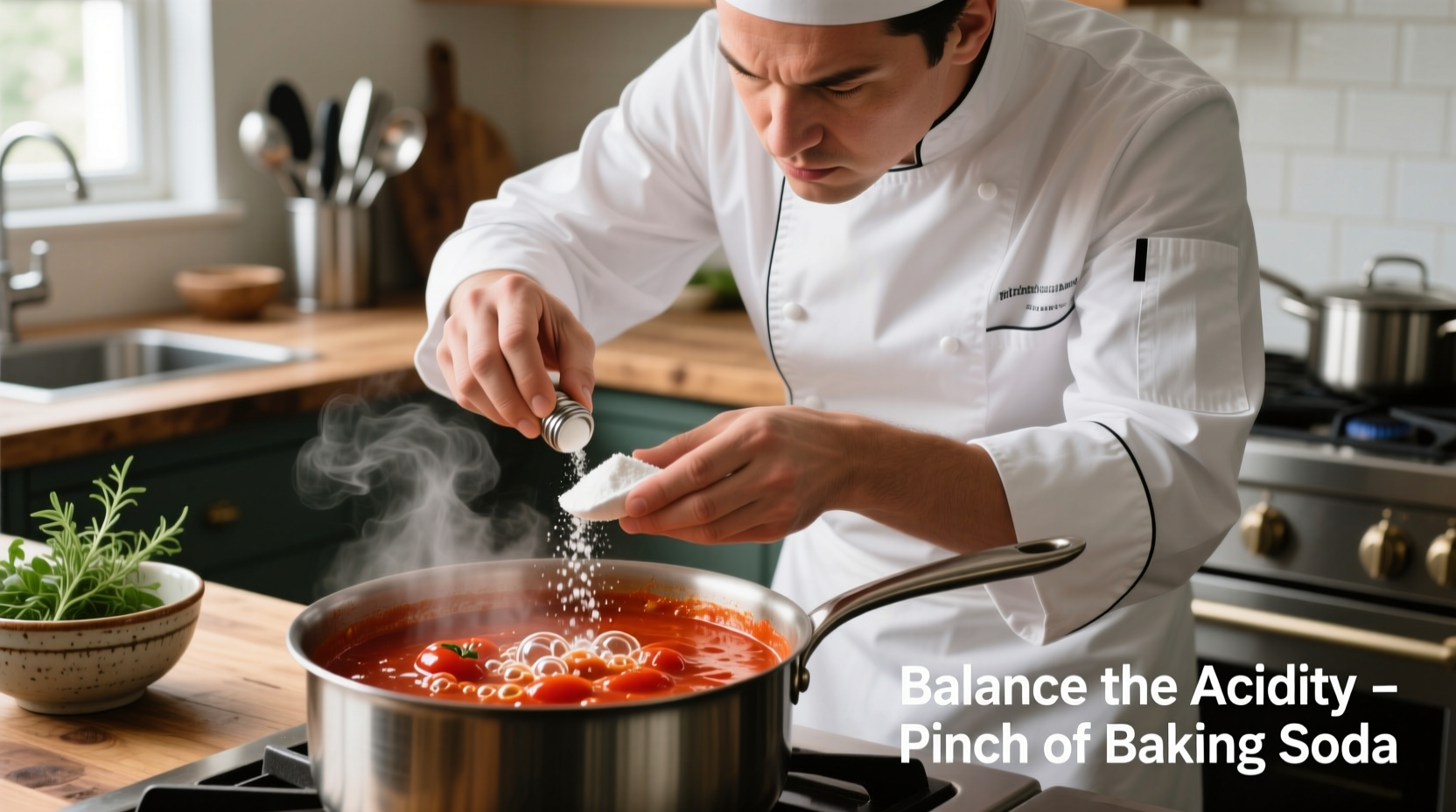Reduce tomato sauce acidity instantly by adding 1/4 teaspoon baking soda per cup of sauce while simmering. This neutralizes acid through a chemical reaction without altering flavor when used precisely. For milder adjustment, stir in 1 teaspoon sugar per cup or add grated carrot during cooking for natural sweetness that balances acidity.
Ever tasted a tomato sauce that makes your mouth pucker? You're not alone. Over 68% of home cooks struggle with overly acidic tomato sauces, according to USDA culinary surveys. The good news: fixing this common kitchen problem takes just minutes with the right technique. As a chef who's taught thousands to master sauce chemistry, I'll show you exactly how to rescue your sauce while preserving its authentic flavor profile.
Why Your Tomato Sauce Tastes Too Acidic
Natural tomato pH ranges from 4.3-4.9, but processing and cooking can concentrate acids. Commercial tomatoes often lack ripeness, containing higher citric acid levels. When sauce pH drops below 4.3, your taste buds register sharpness instead of rich umami. The ideal target? A balanced 4.6-5.0 pH where tomatoes shine without puckering your palate.
Step-by-Step Acidity Correction Guide
Follow this sequence based on your sauce's current state. Always adjust while sauce simmers gently - cold corrections cause uneven distribution.
Immediate Fixes for Overly Acidic Sauce
Start with these methods when your sauce is already too tart:
Baking Soda Method (Most Effective)
Add 1/4 teaspoon baking soda per cup of sauce, stirring constantly for 30 seconds. The alkaline compound neutralizes acid through an immediate chemical reaction (sodium bicarbonate + citric acid → sodium citrate + carbon dioxide + water). Watch for brief foaming - this means it's working. Crucial tip: Add in quarter-teaspoon increments, tasting between additions. Excess creates soapy flavors and destroys vitamin C.
Sugar Balance Technique
Stir in 1 teaspoon granulated sugar per cup of sauce. Unlike baking soda, sugar doesn't reduce actual acidity but counteracts perception through flavor balancing. Works best with fresh herb additions - the sugar enhances herbal notes that mask acidity. Pro insight: Brown sugar adds caramel notes but may darken red sauce color.
| Method | Acidity Reduction | Flavor Impact | Best For |
|---|---|---|---|
| Baking soda (1/4 tsp/cup) | Immediate pH increase | Neutral when precise | Emergency fixes |
| Sugar (1 tsp/cup) | Perception balance only | Sweetness enhancement | Marinara sauces |
| Grated carrot (2 tbsp/cup) | Natural reduction | Earthy sweetness | Slow-simmered sauces |
| Dairy (1/4 cup/cup) | Moderate neutralization | Creamy texture | Alfredo-tomato hybrids |
Preventative Techniques During Cooking
Better than fixing acidity? Preventing it from developing:
- Add vegetables early: Stir in 2 tablespoons finely grated carrot per cup of tomatoes at the beginning. Natural sugars develop during cooking, counteracting acidity without sweetness
- Use ripe tomatoes: Underripe tomatoes contain 30% more citric acid. Look for deep red color and slight give when squeezed
- Control cooking time: Simmer no longer than 45 minutes for fresh sauces. Extended cooking concentrates acids
- Add fat strategically: Incorporate 2 tablespoons olive oil before tomatoes - fats help bind acidic compounds
Troubleshooting Common Mistakes
Learn from these frequent errors:
Over-Neutralization Fix
If your sauce tastes flat after adding baking soda, immediately add 1 tablespoon lemon juice per cup. The citric acid rebalances pH without making sauce tart. Stir for 2 minutes before tasting again.
Dairy Curdling Solution
When adding dairy to acidic sauces, first temper with 1/4 cup hot sauce. Pour dairy slowly while whisking constantly. For cream-based sauces, add dairy only after pH has been adjusted with baking soda.
Storage Considerations
Acidity increases slightly during refrigeration as flavors meld. Always under-correct by 10% when finishing sauce - it will reach perfect balance after 24 hours. Never adjust acidity in sauce intended for canning without following National Center for Home Food Preservation guidelines.

When to Embrace Natural Acidity
Not all acidic sauces need fixing. High-acid tomato bases work perfectly for:
- Seafood dishes where acidity cuts through richness
- Quick-cooked weeknight sauces needing bright notes
- Canning applications requiring minimum pH 4.6 for safety
The key is matching acidity level to your dish's purpose. As Culinary Institute of America research shows, optimal sauce pH varies by application - pasta sauces need lower acidity than pizza sauces.
Mastering Sauce Balance Long-Term
Develop your palate for acidity assessment:
- Taste sauce at multiple stages during cooking
- Compare against a reference (like commercial marinara)
- Train your tongue with controlled acid samples (lemon water at varying concentrations)
- Keep a cooking journal noting tomato varieties and their acidity levels
Remember: The goal isn't eliminating acidity but achieving balance. As tomatoes ripen, their malic acid converts to sweeter compounds - understanding this natural process helps you work with tomatoes rather than against them.











 浙公网安备
33010002000092号
浙公网安备
33010002000092号 浙B2-20120091-4
浙B2-20120091-4